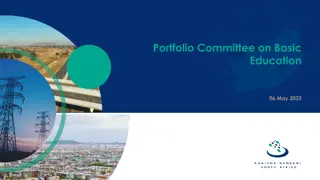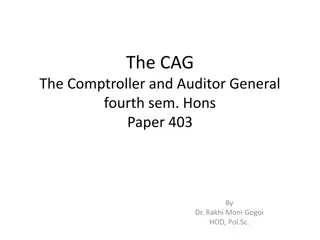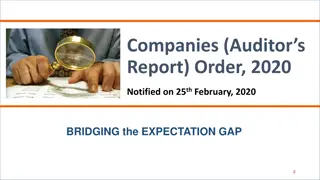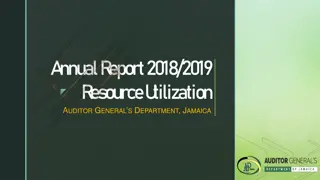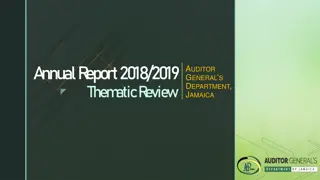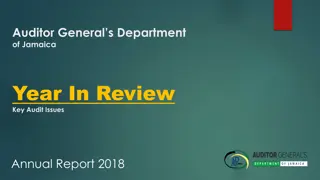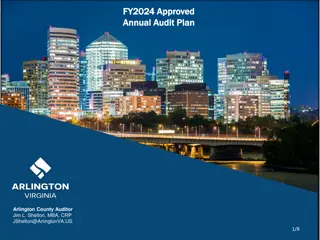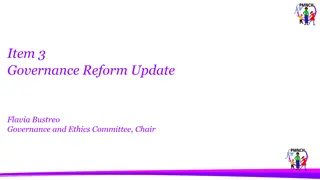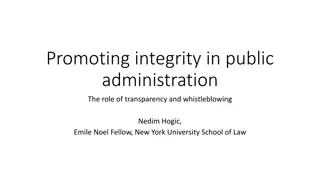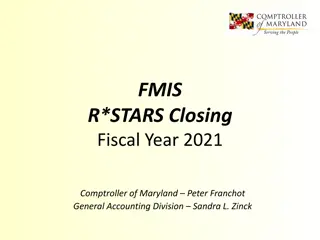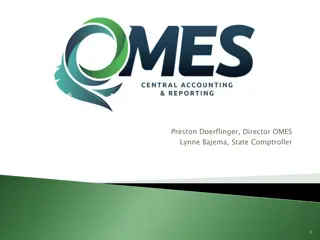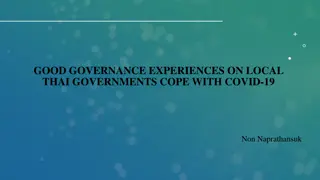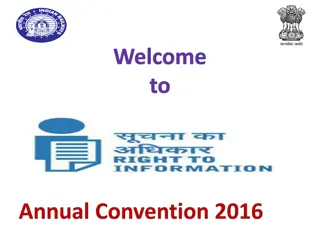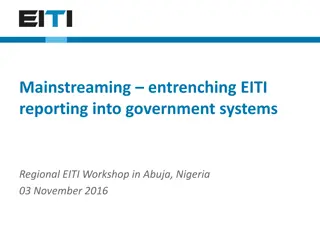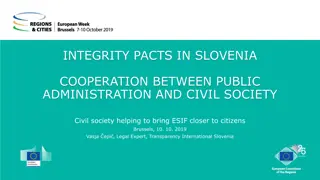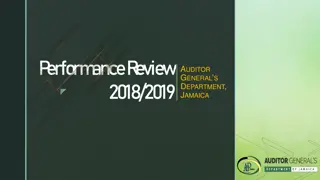Transparency, Accountability, and Good Governance in PRIs: Role of Comptroller and Auditor General of India
The role of Panchayati Raj Institutions (PRIs) in India has been a subject of debate, with a push for decentralization in the 1990s. However, challenges exist in the mismatch of capacities and responsibilities, potential for decentralized corruption, and efficiency issues. While some advocate for stronger support for PRIs, the need for balancing power and responsibility while promoting transparency and good governance remains crucial. Efforts like ICT tools and social audits are aiding in addressing corruption issues. The dilemma lies in not overwhelming new institutions with formalities while fostering a culture of accountability and transparency.
Download Presentation

Please find below an Image/Link to download the presentation.
The content on the website is provided AS IS for your information and personal use only. It may not be sold, licensed, or shared on other websites without obtaining consent from the author.If you encounter any issues during the download, it is possible that the publisher has removed the file from their server.
You are allowed to download the files provided on this website for personal or commercial use, subject to the condition that they are used lawfully. All files are the property of their respective owners.
The content on the website is provided AS IS for your information and personal use only. It may not be sold, licensed, or shared on other websites without obtaining consent from the author.
E N D
Presentation Transcript
Transparency, Accountability and Good Governance in PRIs ROLE OF COMPTROLLER AND AUDITOR GENERAL OF INDIA
What should be the Role of PRIs in India has been a much-debated question. Even Founding Fathers like Mahatma Gandhi, BR Ambedkar and JL Nehru had differences of opinion. The 1990s was a decade of decentralisation. India also amended its constitution to give more powers to ULBs and PRIs. was a popular decentralization. A Bit of History- The problem of Mindset There drive towards greater However, In a powerful paper written in the mid-nineties, titled, The Dangers of Prud homme made a strong case to be conservative when dealing with how much power and responsibility should be devolved to local governments. Decentralization , Remy
..Contd He challenged governance decentralization was strong. the classical most argument responsive that when was He said that the assumption that various local jurisdictions have different tastes or preferences is wrong. The priority in most developing countries is to satisfy basic needs, which are typically not too variable across jurisdictions and are well understood.
.Contd Prud homme decentralization mismatch of capacities with responsibilities; both are constant bugbears of governance even today. had a lot to say about the and corruption, and There available resources and promised expenditures. may be a gross mismatch between Most important, Decentralization may lead to decentralization of corruption. Why is this decentralized corruption is more dangerous than normally occurring centralized corruption?
Contd Decentralised efficiency, because it leads to the supply of services for which the levels of kickbacks are higher. leaders may channelize projects where leakage is inevitable, considerable and easy to engineer. corruption decreases allocative Local money in those Example: concentrate on putting mud on bad roads, only to see it being washed away in the rains, and then redo the roads again. It leads to the need for greater investment in corruption-avoiding strategies. But today we also have ICT tools, social audit, geo tagging which were not available in 1995. Trust-Case of ICDS in J&K.
On the other hand, there are strong supporters of PRIs. Vice Chairman of the Planning Commission said that the term Financial leakage should be used instead of corruption in the context of PRIs. Today direction of change is not debatable. Decentralisation is the way to go. This creates a dilemma/Challenge. On the one hand, these institutions are new (at least in J&K) and have yet to take root. So, these institutions can't be excessively burdened with procedures and formalities. On the other hand, it is perhaps the best time to inculcate a sense of responsibility, transparency and good governance. Power and Responsibility go hand in hand in Government. The Mindset
So, in whatever camp you are- The importance of Transparency, Accountability and Good Governance can t be denied. Every Institution/Department dealing with PRIs needs to change its mindset first. This will go a long in ensuring transparency, accountability and Good Governance. Eg: One such mindset is superiority.
The Jammu and Kashmir Panchayati Raj Act was enacted in 1989. The Rules under the act were framed in 1996. (J&K has a long history of PRIs going back to 1935) The Act establishes a three-tiered Panchayati Raj system, including Halqa Development Council, and District Planning and Development Board Development Council). The Panchayat Elections have been held only thrice in Jammu and Kashmir till date (2001, 2011 and 2018). The DDO powers were Panchayat (Sarpanch) in 2019. The DDO power has not been given to Block Development Councils and District Development Councils (Not Clearly) Status of PRIs in J&K-The 4Fs: Panchayat, Block Funds, functions, Functionaries (renamed as District first given to Halqa and Functionality
Although the 73rd Constitutional Amendment Act was not formally applicable to the state of Jammu and Kashmir before 2019, it was referred to in Committees constituted by the State Government to study the devolution to PRIs. Administrative Government Order No: 1126-GAD of 2011 dated 22/09/2011 devolved the activities related to 14 Departments to PRIs. General Department vide This was a ground breaking order which has hardly any parallels in the country. Later vide amendment (in 2018) to the Jammu and Kashmir Panchayati functions/activities of 21-line transferred to PRIs. Raj Act departments 1989, the were
Functions Delegated Agriculture, Horticulture, Animal Husbandry, Sheep Husbandry and Fisheries Public Health Engineering, Irrigation and Flood Control Department Forest and Social Forestry Tourism Public Works (Roads and Building Department) Rural electrification, power and energy Disaster management Libraries Sports and Cultural Activities Health and Family Welfare Department Social Welfare Department Consumer Affairs and Public Distribution Department Rural Development Department (Including rural Sanitation) Education Department Revenue Department Issue of Certificates Statistics and Planning Co-operation Rural Environment and Ecology Knowledge Management Community Asset Management 1. 9. 17. 18. 10. 19. 2. 11. 20. 12. 3. 21. 4. 5. 13. 6. 14. 7. 15. 8. 16.
Status of Funds Only funds of the 14th FC, Back to Village (B2V) and CAPEX Panchayats. REVENUE OF PRIS (LAKH) were transferred to 14th FC Performace Grants B2V 140434 136038 Takeaways: 89605 PRIs are still taking roots Gaps in elections had significant impact on every aspect of functioning of PRIs. 42900 42900 28208 27910 18279 6605 6605 4342 2018-19 2019-20 2020-21 2021-22 TOTAL EXPENDITURE
Transparency in government refers to the openness and accessibility of government information to the public. actions, decisions, and Accountability democratic government officials and institutions to answer for their actions and decisions, particularly to the public they serve. government societies. in is a crucial the concept responsibility in of It refers to Transparency, Accountability and Good Governance Good governance refers to the principles and practices that promote effective, accountable, transparent, and responsive government. Responsive Participative Inclusive Visionary
Use of ICT Tools has increased significantly during the last decade (MIS, Geo-Tagging, e-GramSwaraj, Auditonline etc) The mechanism to ensure transparency, accountability and good governance has been included in Panchayati Raj Act. Constitution of Gram Sabha- Responsive, Participatory Budgeting Constitution of Ward Sabhas- Responsive Constitution of Committees Management, Human Resources, Employment Generation, Finance and Planning) - Visionary Provisions of Social Audit- Visionary, Grievance Redressal Capacity Building Internal Audit Visionary, Capacity Building External Audit By CAG - Visionary, Capacity Building The need is to make these institutions vibrant. Other tools such as Citizen Charters, Community Score Cards, and Citizen report cards Institutionalisation? Participative, Inclusive, Participative, Inclusive, (Natural Resource Status may be explore-Limitations?
Capacity vs Responsibility of Participative Planning, and Committees have been imposed from the top without explaining the proper context. Most the ideas such as Gram Sabha, Reasons for the Gap between Theory and Practice Too much importance has been given to the achievement of targets without focusing on the process. Eg-Preparation of Gram Sabha Development Plans Programs according to the need representatives. simplification documentation. Capacity-building must of be made elected these Continuous of procedures and
In J&K, CAG is not the Primary Audit Institution in case PRIs. The primary responsibility of the Audit is with the Director of Local Fund Audit and Pension. The audit of CAG is supplementary. These institutions are relatively new. Auditing these institutions with the same yardstick as departments will be harsh. The core area of these institutions is service delivery. That is the benchmark the Audit Reports/Audit observations are focusing on. If an asset is created Was there a need for the asset (pre-asset impact analysis)? Is the asset being properly (Post impact analysis)? Is the asset part of a long-term vision? Other issues are also addressed (such as codal formality, capacity building etc) Other Areas of focus: Plan analysis and Budget Analysis, These aspects of accountability and good governance can t be addressed by the use of ICT only. Use of ICT should free the human resource to tackle larger issues but many times use of ICT itself becomes an end itself. that of some established Mandate and Audit Approach of CAG
Contrary to the popular perception CAG is not a fault-finding institution. Contributing to good governance is the mandate of CAG. The good practices noticed during the audit are being complied for circulation. Instead of pointing out the random cases of irregularity, the focus is to see institutions in totality. Shortcomings noticed during the audit are also being complied for circulation. Steps taken by CAG to strengthen the PRIs Focus on correction/prevention. meetings solution to practical problems Discussion with stakeholders- Simplification of Reports so that these reports serve as a medium of training. Simplification of Rules/Regulations, Provisions. Audit Diwas and Citizen Feedback
Major Findings Planning Process Execution of Work Post Execution Non-preparation of Gram Sabha Plans or five-year plans Non-involvement of the community Selection of works: At all three level Selection of BDC and DDC Not familiar with financial rules and regulations Eg : Statutory deductions Non familiarity with other Policy decisions. Eg: E-waste and plastic waste management Non-conducting Audit Social Development Works by
contd Manpower Management Resource Constraints Appointment of Panchayat Account Assistants Why-steps are not taken? Clarity? Capacity Building?
Fatehpora Woman participation in gram sabha, use of ICDS to mobilise women in governance issues. Panchayat sarpanch, (Baramulla) increased female Gram Panchayat Takiya Batpora of Block Kunzer Child friendly initiatives- increased enrollment,low drop out rates, Anganwadi centres, health tournaments etc Good Practices checkups, sports Sadiwara Panchayat, Anantnag district- Successful cleanliness Sarpanch with involvement of villagers campaign by
Good practices must be shared, and these practises must be emulated by other gram panchayats. Individual praiseworthy but more focus should be on institutionalisation of good practises so that good work goes on. efforts of Sarpanches are Good Practices adopted in panchayats of other states should also be shared. The officers of administrative along with CAG has a role to play in it. department Not excellence , initiative and innovation islands, but, an entire sea of
Under 14th FC Panchayat has created an asset (Fair price Shop) by utilizing Rs 4.72 lakh. Audit Case Study 1: Construction of building for Fair Shop (Panchayat: Drangbal, Baramulla) It is a good step as Panchayat has created a revenue generating asset. No rent has been fixed for the asset created. building has without any rent agreement and rent charges. The been handed over There is a good commission to the dealer from Food Civil Supplies Affairs Department who runs the shop. Building? Revenue? Good Governance? & Consumer Capacity Generation of
The road was taken up for construction under two programmes i. back to village and Area Development Plan of DDC Baramulla in the year 2021-22. Audit Case Study 2: Construction of road from Katyanwali to Khaitangan under Area Development Plan[DDC Baramulla] The construction of road was taken up under Back to village Programme in the year 2021- 22 and started Katyanwali. from Khaitangan to The construction of road was started from Katyanwali to Khaitangan another end under Area Development Plan of DDC of the same year by two different contractors. Both the contractors completed the allotted quantity of road. However, in the middle 1.40 KM of road was not taken up for execution as the same was not allotted to the contractors and the road could not be completed till date
Audit Case Study 3: Preparation of the Area Development Plan (Halqa Panchayat, Singhpora) During the course of audit of records viz. approved copy of Register, it was noticed that no ward majlis in respect of approved in the annual development plan were organized. ADP and Karwai the works/proposals Community Participation? Accountability? Ownership of Assets? Organic vs Forced participation?
Vermicomposting pit was completely unused as no dumping was done for vermicompost thus rendering all investment. No supervision / supervision plans are in place in the panchayat to verify the functionality and maintenance of assets thus created. Case Study: Construction expenditure as idle of In the bill passed for payment, item shown was corrugated GS sheets roofing including vertical / curved surface fixed with polymer coated J or L hooks, bolts and Nuts however it was observed that no hooks, bolts or nuts were used and the GS sheets were pre used of low quality as there were lot of previous nail holes in the sheets. Vermicompos ting pit near Land of Mr X(Kansipora- The work was completed more than 15 months ago. A) Utility/Use of Assests? Accountability?
Audit Case Study 4: Construction of irrigation Khul (Doorie Khul) from the H/o Mr A at Delina-A) No during execution photograph was taken. Sign board showing the completion of the work has been prepared on retaining wall of some other work Utility of the asset? Maintenance of the asset?
Future Directions THESE GRAM SABHAS AND WARD SABHAS VIBRANT. THE PARTICIPATION PEOPLE AT EVERY OWNERSHIP OF ASSETS WILL NOT BE DEVELOPED. IS NEED TO MAKE SOCIAL AUDIT NEEDS TO BE INSTITUTIONALISED. LIMITATIONS SOLUTIONS ACCOUNTABILITY TRANSPARENCY NEED TO ACKNOWLEDGED. THE ICT SOLUTIONS NEEDS TO BE CONTINUOUSLY IMPROVED. OF ICT FOR AND QUALITY DELIVERY SHOULD BE THE BENCHMARK THESE INSTITUTIONS. OF SERVICE ACCOUNTABILITY MUST BE COMPREHENSIVE- ONLY OF ADMINISTRATIVE DEPARTMENTS ALSO- EG IN AREAS CAPACITY BUILDING. WITHOUT NOT BUT OF TO ASSESS PRIS STAGE, SUCH AS



